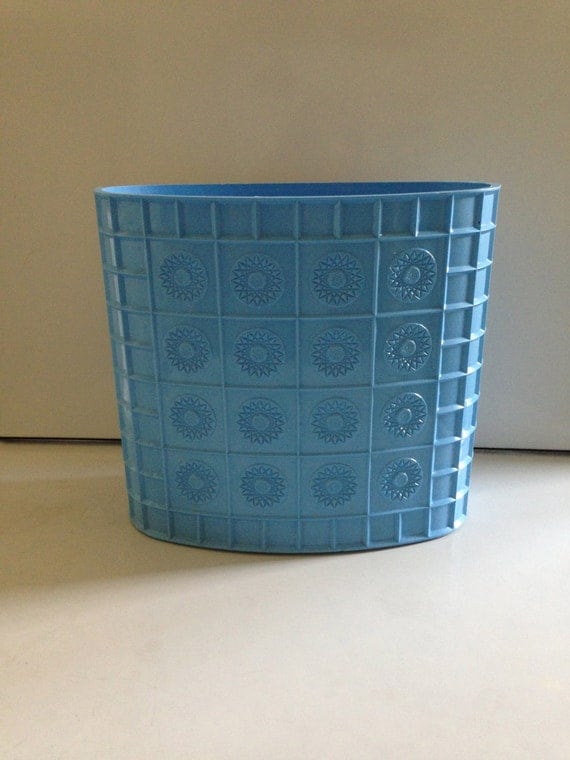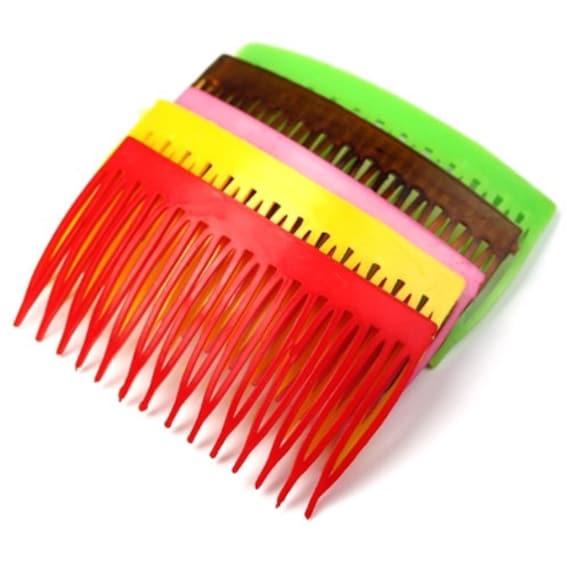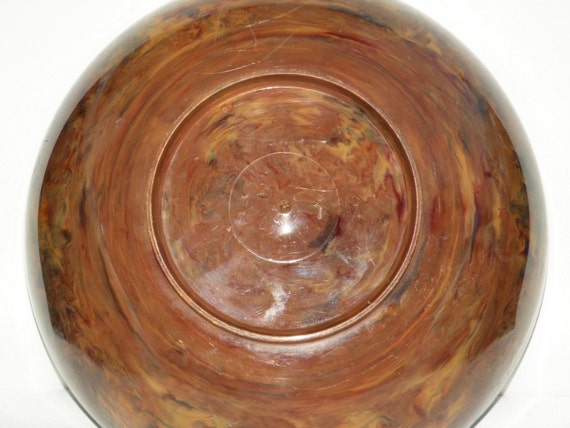If I could sound like one of the Brady bunch saying, "Marcia, Marcia, Marcia,", you'd hear me saying "Melmac, Melmac, Melmac" because that's a lot of what I talk about here at Melmac Central. I don't want to discount the other wonderful plastics that were out there (and still are today). One being, the every so popular Styron by Dow Chemical Company.
So , here are some quick facts:
- Dow Chemical was founded by Herbert Henry Dow in 1897.
- Styron was Dow's brand of Polystyrene plastic. All Styron is Polystyrene but not all Polystyrene is Stryon. Why? Quite simply put, it could have been manufactured by another company and not entitled to the Styron label. (Just like all melamine is technically not Melmac, as Melmac was a trademark of the American Cyanamid company, Styron was a trademark of Dow.)
- Dow Chemical is credited to manufacturing this plastic as early as the 1930's, but in 2010 Styron branched off into it's own entity. (Dow Closes Sale of Styron Division to Bain Capital for $1.63 Billion ) This new company, is still making plastics today!
- Styron is a relative of Styro-foam, in actuality the foam was made from an extruding process of the Polystyrene.
- It has been used in everything from radio cases, knobs, toys, kitchenware, industrial plastics, airplanes, cars, and so many things you'd be amazed. From the juice reamer to the 1950's kid's toys, Styron was everywhere, and still is today! .
How Colors Were Selected To Appear on Merchandise
Let's say trash can designer John Blond was selling a warehouse full of EZ-trashcans to all the old Woolworth's stores. The order was ready for production but John Blond wasn't sure what colors to mold in. In most cases, .John Blond would go to the molding company , ABC Molding and meet with Howard in the production department. Howard would be the one overseeing the project and working with John Blond. In some cases, the designers would deal direct with a salesman, and the salesman would go to the production department and handle colorization. This of course depended on the importance of the designer, size of the order, and staff of the factory.
In this case, Howard from production gave John Blond a keychain (hence the holes in the samples scroll down below) of popular colors. If John Blond was still not certain, a sample box would be provided by the manufacturer of the plastic compound (above) hence, Dow.
John Blond would now take some time and review all the glorious colors in the box above to see what he may want for trashcan colors. In some cases, John Blond would order prototypes, to see how the different colors would mold on the can. This means Dow would send enough to mold a few trashcans to the factory, so John Blond could see his can in real life. In this case, John Blond settles on standard color chip K136 , below for his EZ-Trashcans.
 |
| This trash can is $22 at Two Twins Vintage on Etsy. |
Not Always That Easy : Custom Colors and Hue Differences
If he could not settle on something he liked, or perhaps he wanted a custom color to set him apart from other trashcans on the market, he may order a custom blend or custom color. This would be done by mixing two of the standard colors in the box to get a custom color. Gradual additions or deletions of said colors would take time to see how much granules of color A in part to granules of color B would be added. This could have taken place at the factory level or special order from Dow.
This would most likely be more expensive for John Blond to have his can molded, due to extra time and extra coloring, and unless he was selling his product to high end department stores, it would behoove him to stick with a standard color. So, for Woolworth's, he would have went standard or overstock colors. Read on.
An exception to the rule in expense with custom coloring would be overstock. If a molding company had ordered in the wrong colors for a customer , or had a job cancelled they may have been stuck with much leftover product, in this case, John Blond may luck out with a great deal on a special color or custom blend (mottled, or end of day) just to move the unused batch. If Dow for some reason also mixed a batch wrong, or anticipated selling more of a color and it flopped, this color may have also been on sale. This is why you can have three Lustro-Ware red canister sets next to one another and see a slight variation of color, almost not noticeable unless you really sit them together. This could be a slight variation in the mixing, or the factory adding a part of another color to stretch it, or a slightly off hue color being moved at a cheaper rate.
 |
| Look closely and think about the objects you had in your house as a kid! |
Styron Blasts Away Melmac
Commercially speaking, I am quite sure that sales of Styron had to be at least ten to fifty bazillion times that of the sales of melamine or Melmac. Keep in mind plastics factories that made melamine dinnerware also molded other forms of plastics. Melmac was widely used in dishes, some boats, and other items but not as widely used as Polystyrene.
In a factory at the end of the day, mass production of dimestore items such as cheap toys made of Styron would have certainly quadrupled the orders received for melamine dinnerware. Maybe you didn't know that everything you touched as a child was Styron, because most of it is not labeled as such, but it was a widely used plastic for making everything. Not to mention, it's still being used today. Most melamine of today is made in China, now and no where near the quality grade used back in the 50's. Therefore, Styron wins hands down.
 | |
| These lovey combs could be made of Polystryene. You can buy them for $7 at MkSupplies.etsy.com |
What Did You Have of Styron?
From a funky lime green comb to a blue plastic ruler, you don't know where Polystyrene may have lurked in your home. It was hard plastic.For instance, a ring box could have been made of polystyrene, a comb or a toothbrush--all made thicker and more durable than perhaps a thin plastic cup that you may have chipped or cracked as you knocked it off the counter. Perhaps you would never have realized both the toothbrush handle and the thin cup were made out of the same plastic!
Thinner Styron examples would have been Mom's Lustro-ware, watering pitchers, cheap disposable plastic utensils, and ice cream parlor spoons. Perhaps a dark blue record case, or orange covered sewing kit made of Styron color chip K136 jogs the memory. Fishing boxes were made of Styron were mottled in color and molded of the same plastic would have been some lures and bobbers! Here are some ideas....
 |
| Let's go over some forms of Styron you may see around Grandmom's house... |
CHARMS! K76 is a dark blue, and may have very well been used on small toys such as these. What comes to mind immediately is cowboys and Indians or small farm sets in dark blue. Charms or cracker jacks or dimestore items. Pictured here just for show are small hockey players made of a translucent polystyrene, most likely color code K13 mixed with K76, and were made in the USSR. You can buy them at Soviet Era on Etsy for $9.
LUSTRO-WARE! K56 is a deep red, darker than a K50 which was the bright 50's red. An example of the K56 is here, in Lustroware. These jugs are lightweight and great for tea or water. There are mold lines where the plastic was molded in two cavities then joined at the seam and they sometimes look sloppily done. This pitcher is circa 1940s-1950's. This one, is $32 and available at NewLifeVintageRV on Etsy.
TOYS! K56 Perwinkle blue stands out from a wide variety of turquoise and darker blues, and was most likely used on lots of children's items. Cars for boys, musical instruments, and those tiny boy blue piggy banks you see as party favors. Surely you've seen this color before in your travels. This car is in the original box in the "blue plastic toy series" and is $39.99 available at KrausHaus on Etsy.
KNOBS! K102 was a pure white and would have been used on many plastic knobs, from these wonderful 1970's drawer pulls to bathroom cabinet pulls, and even the plastic on old stove knobs or radios. If you wanted a more chalky white, you would have molded with color K104 for a semi translucent look. Creamier white was K94. This whole set is available for $20 at Etsy shop Peleda.
PICNIC PLASTICS K103 This canary yellow was used in kitchenwares, picnic party packs, kid's teething toys, sippy cups , and cheap baby dishes! If you wanted a more muted pale yellow, K117 would have been the ticket. These dishes, $16 at SeaGlassVintage on Etsy.
Now of course these are examples, and without seeing original molding sheets and specs, you don't know for certain these were Dow Plastics, as other companies had different shades and forms of polystyrene available also, but it's safe to say Dow Chemical was one of these largest distributors of their brand of Polystyrene if not the largest. It surely outlived most others!
 |
| This swirly salad bowl incorporated several different color hues. It's for sale at RetroChalet. |
What's laying around your house that could be polystyrene or Styron? Tell me!
More posts on Polystyrene Here.
See posts on Lustro-Ware here.
Crazy Fact: I spelled Stryon wrong a million times, when in fact it's spelled STYRON (STY-RON not STR-YON)


